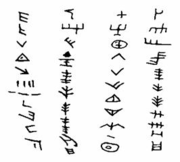
Dispilio Tablet
Encyclopedia

George Hourmouziadis
George Hourmouziadis is a Greek archaeologist and Professor Emeritus of prehistoric archaeology at the Aristotle University of Thessaloniki. He led excavations in many prehistoric settlements in Thessaly and Macedonia and on 1992 he started the excavation of the neolithic lakeside settlement of...
's excavations of Dispilio
Dispilio
Dispilio is an archaeological site containing remains of a Neolithic lakeshore settlement that occupied an artificial island near the modern village of Dispilio on Lake Orestiada in Kastoria Prefecture, Macedonia, Greece....
in Greece
Greece
Greece , officially the Hellenic Republic , and historically Hellas or the Republic of Greece in English, is a country in southeastern Europe....
and carbon 14-dated to about 7300 BP (5260 BC). It was discovered in 1993 in a Neolithic
Neolithic
The Neolithic Age, Era, or Period, or New Stone Age, was a period in the development of human technology, beginning about 9500 BC in some parts of the Middle East, and later in other parts of the world. It is traditionally considered as the last part of the Stone Age...
lakeshore settlement that occupied an artificial island near the modern village of Dispilio on Lake Kastoria in Kastoria Prefecture
Kastoria Prefecture
Kastoria is one of the regional units of Greece. It is part of the region of West Macedonia. Its capital is the town of Kastoria.-Geography:...
, Greece
Greece
Greece , officially the Hellenic Republic , and historically Hellas or the Republic of Greece in English, is a country in southeastern Europe....
.
Discovery
The lake settlement itself was discovered during the dry winter of 1932, which lowered the lake level and revealed traces of the settlement. A preliminary survey was made in 1935 by Antonios KeramopoulosAntonios Keramopoulos
Antonios Keramopoulos was a Greek archaeologist. He conducted numerous excavations studying Mycenean and classical Greek antiquities during the early 20th century, including excavations at the Agora of Athens and at the palace of Mycenae. He also wrote studies about later Greek history...
. Excavations began in 1992, led by George Hourmouziadis, professor of prehistoric archaeology at the Aristotle University of Thessaloniki
Aristotle University of Thessaloniki
The Aristotle University of Thessaloniki is the largest Greek university, and the largest university in the Balkans. It was named after the philosopher Aristotle, who was born in Stageira, Chalcidice, about 55 km east of Thessaloniki, in Central Macedonia...
. The site appears to have been occupied over a long period, from the final stages of the Middle Neolithic
Neolithic
The Neolithic Age, Era, or Period, or New Stone Age, was a period in the development of human technology, beginning about 9500 BC in some parts of the Middle East, and later in other parts of the world. It is traditionally considered as the last part of the Stone Age...
(5600-5000 BC) to the Final Neolithic (3000 BC). A number of items were found, including ceramics, wooden structural elements and the remains of wooden walkways, seeds, bones, figurines, personal ornaments, flutes— one, dated to the sixth millennium BCE, is the oldest ever found in Europe, and one of the most significant findings, the inscribed tablet.
The tablet's discovery was announced at a symposium in February 1994 at the University of Thessaloniki. The site's paleoenvironment, botany, fishing techniques, tools and ceramics were published informally in the June 2000 issue of Επτάκυκλος, a Greek archaeology magazine and by Hourmouziadis in 2002.
The tablet itself was partially damaged when it was exposed to the oxygen-rich environment outside of the mud and water it was immersed in for a long period of time, and it is under conservation. The full academic publication of the tablet apparently awaits the completion of conservation work.
See also
- Vinca cultureVinca cultureThe Vinča culture is a Neolithic archaeological culture in Southeastern Europe, dated to the period 5500–4500 BCE. Named for its type site, Vinča-Belo Brdo, a large tell settlement discovered by Serbian archaeologist Miloje Vasić in 1908, it represents the material remains of a prehistoric society...
- Old European scriptOld European ScriptThe Vinča symbols, sometimes called the Vinča script or Old European script are a set of symbols found on Neolithic era artifacts from the Vinča culture of southeastern Europe....
(Sometimes called "the Vinča alphabet".) - Tartaria tabletsTartaria tabletsThe Tărtăria tablets are three tablets, known since the late 19th century excavation at the Neolithic site of Turdaş in Transylvania Romania, by Zsófia Torma, which date to around 5300 BC...
- Neolithic EuropeNeolithic EuropeNeolithic Europe refers to a prehistoric period in which Neolithic technology was present in Europe. This corresponds roughly to a time between 7000 BC and c. 1700 BC...
Sources
- G. H. Hourmouziadis, ed., Dispilio, 7500 Years After. Thessaloniki, 2002.
- G. H. Hourmouziadis, Ανασκαφής Εγκόλπιον. Athens, 2006.

